Sweet Auburn Digital Media Initiative
In the Spring of 2016, I paired an advanced seminar course titled Critical Theory, Social Justice, and Philosophy of Design with a design studio titled Sweet Auburn: Birthplace of Ideas. Undergraduate, master’s, and PhD students from a range of backgrounds (e.g., biology, marketing, and digital media) enrolled. The impetus behind combining a studio and a seminar was to connect the theoretical and practical, helping students see the substantial connection of design strategies with the larger ethical and political issues at stake aligned with understanding design as a liberal art rooted in a recognition of the plurality of principles. In other words, I designed this educational experience deliberately to put the vocational and humanistic into conversation.
The seminar course centered on classical and contemporary social justice theories. We read utilitarian, pragmatic, idealist, and feminist theories, tracing the fundamental plurality of their distinct philosophies. We discussed how they each make sense in their particular ways and more importantly how they can serve as companions to enrich understanding and analysis of particular design cases. The Atlanta BeltLine, a revital- ization effort that transforms old railroads to walking and biking paths, emerged as a productive example for our class conversations.
The studio was designed to highlight theoretical issues as practical design matters. Given the offering of the courses though the School of Literature, Media, and
Communication, the studio projects centered on the interrelated themes of communication, interaction, and storytelling. These themes were specific enough to draw in students with diverse special interests, such as urban planning, smart cities, visualization, and mapping, and broad enough to facilitate discussions on a wide-ranging set of social justice issues such as freedom of movement in the city or the politics of recordkeeping and mapping.
Students worked on two projects both centered on the close interplay of analytic and synthetic modes of thinking, the thread of seeing everything in relationship. Aligned with the social justice theme, the first project asked students to design typographic expressions of Maya Angelou’s poem “Still I Rise,” which captures lived experiences of oppression and resistance. The second project asked students to immerse them- selves in a neighborhood in Atlanta and conceive of possibilities that are responsive to its current rather complex situation and might, in one way or another, advance social justice as they saw it. Specifically, students were asked to explore the Sweet Auburn historic district; learn about its history and present situation; and consider how its past and present trajectories (both real and imagined) surface, shape, reinforce, or challenge social justice issues. As students conceived of problems and projects, they were able to see how their particular convictions of justice shaped their ways of framing the situa- tion and conceiving design solutions. Aligned with the ethos of participatory and co-design, the course also facilitated conversations with community partners surfacing various issues through their diverse perspectives. Students were encouraged to work in close collaboration with Sweet Auburn cultural institutions, advancing Martin Luther King’s principle of nonviolent social change and the spirit of Sweet Auburn as the birthplace of ideas. This also enabled discussions of the ethics and politics of working with communities, facilitating firsthand experiences of the methodological dimension of justice formalized through readings such Linda Tuhiwai Smith’s Decolonizing Methodologies (2013) and my own “Doing Justice to Stories” (Parvin 2018).
Together, the two projects enabled a mastery of design methods and techniques closely intertwined with reflection on philosophic groundings of design especially as related to social justice. The parallel unfolding of the theory and studio courses enabled students to experience the collapse of the theory/practice duality. Below is a list of projects that emerged from this educational/participatory initiative.
SAMPLE PROJECTS
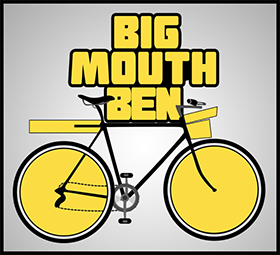
Came From Nothing: The Story of Benjamin “Big Mouth Ben” Graham
Nick Tippens and Ali Yildirim
Came From Nothing is a documentary film and an interactive installation that chronicles the life story of Benjamin “Big Mouth Ben” Graham, an entrepreneur and motivational entertainer who overcame 17 years of addiction and homelessness on Auburn Avenue to become a business owner on that same street. This documentary aims to do justice to Ben’s remarkable, colorful story of resilience by capturing it, aesthetically and thematically, in all of its depth and complexity.
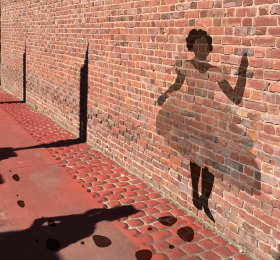
In Her Footsteps
Akansha Gupta, Alyssa Rumsey, and Horyun Song
When walking down Auburn Avenue take notice of the footprints on the sidewalk and let the journey unfold. At the end of the path, you will stand in the shoes of a successful woman. Her silhouette will invite you to experience the past. These public, interactive installations will engage with the rich heritage of Auburn Avenue and seek to preserve and inspire.
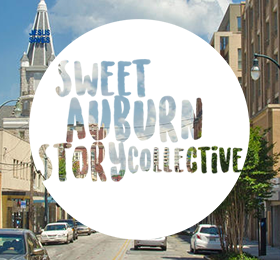
Sweet Auburn Story Collective
Luisa Botelho, Shruti Dalvi, and Abby Golfo
Our project focuses on telling the stories of Sweet Auburn through a collection of cards and an accompanying website. We would like our audience to connect with these cards and continue the conversations. The cards can be held on to or shared digitally and physically, with the hope to track the journeys of the different cards through geotagging.
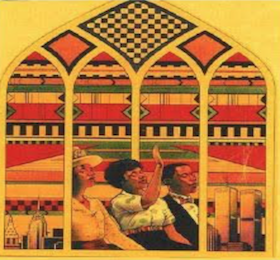
Church of Refuge: Stories from Our Lady of Lourdes
Brooke Bosley and Stephen Song
Our Lady of Lourdes Church was founded in 1912 as the first African American Catholic Church in Atlanta.The goal of the project is to connect, preserve, create, and share stories on how the church provided refuge. The project is a: pamphlet on objects, a website, and an interactive installation on what refuge means to individuals.
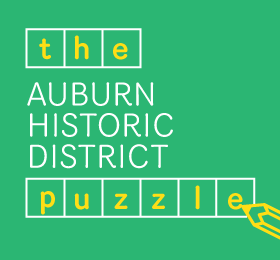
The Auburn Historic District Puzzle
Aditya Anupam, Gayatri Gaekwad, and Sarah Baik
School children visiting The King Center and the Visitor Center on Auburn Avenue often do not engage much with the exhibits in these museums. We respond to this problem through a series of interactive puzzles that connect students better with the exhibits.
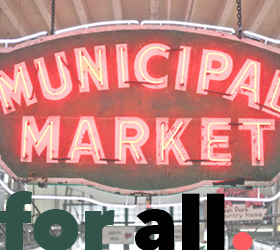
For All
Chloe Kiernicki and Annie Son
As Atlanta’s only public market, the Sweet Auburn Curb Market has always been “for all,” but no one knows about it. We seek to inform visitors on the impact of the nearly 100-year-old market through an interactive wall installation that chronologically shares the market’s personality through stories.

You must be logged in to post a comment.